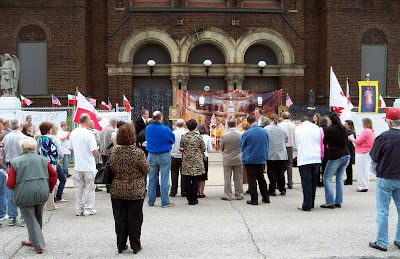There is a parable in Matthew where a fearful servant speaks to his master, "Lord, I know that thou art a hard man; thou reapest where thou hast not sown, and gatherest where thou hast not strewed."* This sort of response would only anger the master. What an indictment―of that 'lord'. Have we not the same situation here?
You, your parents, your grandparents, and for some of you even further back, built these parishes. These original sites were the basements of other churches, school gyms, pool halls and whatever was available. Then with time, money and work a more proper place became home to the parish. The bishops of the time did not pony up the money. You and yours did. Now, in this hour a successor bishop, very like that 'hard man' of the parable, has visited us.
Yet, he has his supporters, or his office with him as the accidental holder. Their defense of him is pitifully weak. It rests ultimately on servile obedience alone. This allows us the traditional tyranny of "pray, pay and obey."
Now, in all of us there resides a conflict between good and evil. None are perfect. None are without sin. Each one of us may be more good than evil, or vice versa. Each one of us may be suited for his current position or not. We are not cast as absolutes, we are all responsible for our behavior. The idea that any leader is to be exalted in extremis is dangerous. To suggest that one can do no wrong, make no errors, that no conditions apply is to allow for the greatest misfortunes.
This theory has its antecedents and adherents. Thomas Hobbes in The Leviathan (1651) allows the sovereign such complete subservience, the only thing he allows us is our life, only at that point can we object. Richard Cheney follows the all power to the 'unitary executive'. These are only modern updates to what the ancients called 'oriental despotism'. One such despot was Pharoa in Exodus. Under that system god resided in the pharoa, only he had rights. Only pharoa was a citizen.
Saint Paul spread the way of Jesus in the greek lands. He taught that, we are fundamentally equal in Christ.
There is neither Jew nor Greek: there is neither bond nor free: there is neither male nor female. For you are all one in Christ Jesus. ― Gal iii.28.At the fall of Rome in the west, there came a 'migration of peoples'. One of a group of slavonic tribes that settled in the eastern Alps, north of the Balkans became, as they are known to-day, the slovenes. In their history, the philosopher Jean Bodin (1566) and later Thomas Jefferson (1776) found the social contract. In a ceremony from the early mediæval period, at least since the 6th century, even after subjugation by germanic overlordship, that continued until 1414, when the Habsburg potenate would not degrade himself to undergo a slavonic peasant rite, the leader would take a yearly oath, later it became only a crowning ceremony. Well, in that rite, the people pledged to follow the knez (duke) for the year, and if the knez failed to serve his people, he forfeited his life. The leader of his people was responsible to the people. There are many nations amongst the slavs, the slovenes are a small one; outside of the homeland, Cleveland, Ohio, had the largest concentration; a few, a very few, know their ancient heritage.
Non est Judǽus, neque Græcus : non est servus, neque liber : non est másculus, neque fémina. Omnes enim vos unum estis in Christo Jesu.
We have three options in the bishop-parishioner relationship. We have the pauline-christian one, which Lennon rejects. We have the slavonic-democratic social contract theory, which he certainly would not countenance. We have the pharonic-leviathan rules absolutely theory, which we reject.
_____________
*Matthew xxv. 24.



























